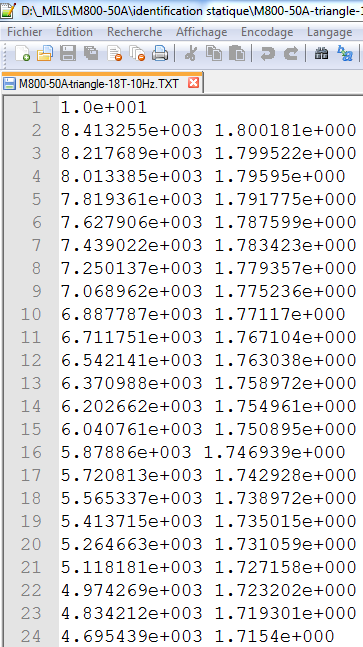Since version 2026, Flux 3D and Flux PEEC are no longer available.
Please use SimLab to create a new 3D project or to import an existing Flux 3D project.
Please use SimLab to create a new PEEC project (not possible to import an existing Flux PEEC project).
/!\ Documentation updates are in progress – some mentions of 3D may still appear.
MILS input and output files formats
General remarks
The input data required by MILS is given by a set of text files in ASCII format, each one containing magnetic measurements (i.e., magnetic flux density B and magnetic intensity H values) and one frequency value. An individual file corresponds to a full B-H hysteresis loop measured in a sample of the steel sheet subjected to a specific magnetization cycle.
These measurements must be obtained using a proper experimental setup, consisting of an Epstein frame built from a sample of the steel sheet and driven by a controlled voltage source. The source must be driven to impose a triangle wave of magnetic flux density B(t) of adjustable frequency and amplitude to the ferromagnetic sample.
Moreover, the measurements should be acquired in steady-state; that is, no transient phenomena should be included in the measured hysteresis loops. Further information on the test bench required to acquire input data for an LS identification may be found in the bibliographical references.
Input file format for static and dynamic measurements
- The first line of the text file contains a single frequency value given in hertz (Hz) and equal to the frequency of the triangle wave B(t) imposed by the source. Equivalently, this frequency corresponds to the period required to complete a full hysteresis loop in the material.
- From the second line onwards, each line of the text file represents a time step and contains two values. The first is the magnetic intensity H (A/m) and the second is the magnetic flux density B (T) in the time step.
-
The measurement file must represent a single loop in steady-state and contain at least 200 time steps or B-H doublets.
Note: The number of time steps in a file is not constrained by an upper bound, and increasing it does not affect the total computation time. On the other hand, the user must ensure that each line or time step of the input file is composed by a B-H doublet, to make sure that the B and H vectors recovered from the file by MILS have both the same length.
Figure 1 below shows an example of a MILS input file containing B-H measurements of a hysteresis loop at 10 Hz.

Two sets of input files are required for a full LS model identification of a steel sheet:
-
For static identification: a set of files containing hysteresis loops, measured with an experimental setup imposing a low-frequency B(t) triangle wave (~10 Hz). Each file in the set corresponds to a triangle wave with a different value of peak magnetic flux density. At least three files or peak values should be included in the set of files used in an LS model identification: 0.5 T, 1 T, and the saturation magnetic flux density of the sheet material.
-
For dynamic identification: a set of files containing B-H measurements obtained with an experimental setup imposing B(t) triangle waves at several frequencies (higher than the static identification frequency), with a peak magnetic flux density corresponding to the saturation of the sheet material.
- Static measurement files in the folder : Static_Identification (to be loaded in the first panel).
- Static measurements for verification in the folder : Static_Validation (to be loaded in the first panel after running a static identification).
- Dynamic measurement files in the folder : Dynamic_Identification (to be loaded in the second panel).
- Measurement files for global verification in the folder : Global_Validation (to be loaded in the third panel).
Output files formats
A successful LS model identification in MILS results in three output files. These files are created in the last step of the identification using the fourth panel Model generation for Flux . Their formats are summarized below:
-
A .mils file containing the LS model of the steel sheet. This file may be imported in Flux to describe the hysteretical behavior of a magnetic region composed of a stack of sheets in an a posteriori computation of the iron losses.
- A .txt file containing a report of the LS model identification.
-
A .xls Excel file, providing loss values (W/kg) evaluated with the LS model for various values of peak magnetic flux density and at different frequencies.
Further reading
LS model identification with MILS
How to use MILS to generate a LS model
Panel 1: Static identification
Panel 2: Dynamic Identification
Panel 4: Model generation for Flux
Bibliographical references on the LS model
Isotropic soft magnetic material: iron sheets described by LS model